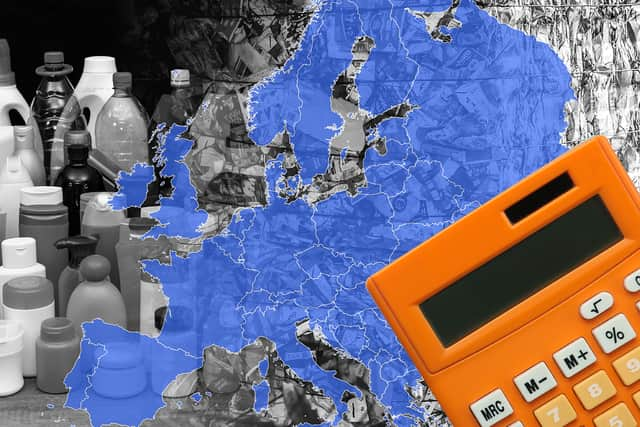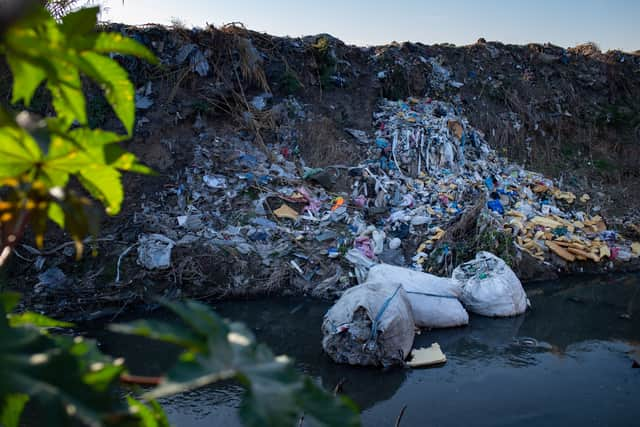Plastic Packaging Tax 2022: what is it, how UK plastic waste compares to EU countries - will it have an impact
and live on Freeview channel 276
The Government’s new plastic packaging tax is a “half measure” that “won’t be enough” to tackle the crisis, environmental campaigners have warned.
The tax is being rolled out from 1 April to encourage the use of recyclable materials and eliminate the amount of plastic ending up in our oceans, on our streets and in landfills.
Advertisement
Hide AdAdvertisement
Hide AdBut campaigners argue that on its own the tax doesn’t go far enough, desperately urging the Government to ‘step up’ and take action on reducing the amount of plastics produced to begin with - before time runs out.
Here we explain what the plastic packaging tax is, how much plastic waste is generated from packaging in the UK compared to other countries and whether or not the tax will be effective in reducing plastic waste.
What is the plastic packaging tax?
A recent poll conducted for GreenPeace UK by YouGov found that 85% of people in the UK want the Government to make retailers cut the amount of plastic packaging they use.
The newest ‘environmental tax’ in the UK is the plastics packaging tax.
Advertisement
Hide AdAdvertisement
Hide AdThe rate of tax will be £200 per tonne on plastic packaging that contains less than 30% recycled plastic, and which is manufactured or imported into the UK (including packaging on finished goods which are imported).
Packaging containing 30% or more recycled plastic will not be chargeable for the tax.
The aim of the tax is to stimulate demand for recycled plastic, creating a greater demand for this material and diverting plastic waste away from landfills.
There are two types of plastic packaging subject to the tax. These are packaging designed to be suitable for:
- use in the supply chain
- single use by the consumer
Advertisement
Hide AdAdvertisement
Hide AdDue to the broad scope of the tax, it will affect a wide range of businesses.
The tax is expected to impact on an estimated 20,000 manufacturers and importers of plastic packaging.
How does UK plastic packaging waste compare to other countries?
The European Union country that generated the largest amount of plastic packaging waste in 2018 was Germany, according to the latest available figures from Eurostat.
They produced more than 3.24 million tonnes worth.
Germany was then followed by the United Kingdom (then still part of the EU), which generated 2.36 million tonnes of plastic packaging waste.
Loading....
Advertisement
Hide AdAdvertisement
Hide AdThe top five countries that produced the largest amount of plastic packaging waste were: Germany, United Kingdom, France, Italy, and Spain.
According to the 2021 Plastics Market situation report by the Waste and Resources Action Programme (WRAP), the total plastic packaging placed on the market is estimated to have declined by 3% between 2017 and 2019, from 2,362 tonnes to 2,289 tonnes.
How much plastic waste does packaging produce?
Packaging is the worst sector for generating plastic waste globally, according to data from OurWorldinData.
Of the 302 million tonnes of plastic waste produced by plastic-producing industries in 2015, almost half (141 million) came from the packaging industry.
Advertisement
Hide AdAdvertisement
Hide AdThe British Plastics Federation (BPF) estimates that the total volume of plastic waste generated each year in the UK is 4.6 million tonnes, of which 2.9 million tonnes is plastic packaging, according to its ‘Recycling roadmap’ published in 2021.
How much plastic waste is recycled?
In 202,0 the total amount of packaging waste in the UK sent for recycling and recovery amounted to 12,608 tonnes, up from 11,836 tonnes in 2018, according to statistics by the Department for Environment, Food and Rural Affairs (DEFRA).


Plastic packaging accounted for 2,480 tonnes of the 2020 total, of which 1,174 tonnes was recycled - 47.4%.
This compares to 2,361 tonnes in 2018, of which 1,704 tonnes was recycled - 43.8%.
Advertisement
Hide AdAdvertisement
Hide AdDespite the amount of plastic packaging being recycled increasing between 2018 and 2020, the amount of plastic waste being created from packaging is also rising.
The highest recycling rate achieved in 2020 was also not for plastic waste - 76.0% of metal packaging was recycled, followed by 75.8% for glass and 65.6% for paper and cardboard, according to DEFRA statistics.
Will the tax have an impact?
UK citizens do not think enough is being done on plastic waste, a survey conducted by WRAP of 4,083 UK adults between 8-21 June 2021 found.
Over half (56%) say the most useful packaging innovation would be making more packaging recyclable.
Advertisement
Hide AdAdvertisement
Hide AdMaja Darlington, a plastics campaigner at Greenpeace UK, said the tax “will only be effective alongside other measures to address the plastic pollution crisis at source, including an ambitious target to cut single use plastic by 50% by 2025 and moving towards reusable solutions which cater to everyone’s needs”.
She continued: “A plastic packaging tax is one tool in helping us tackle the plastic pollution crisis, but on its own it won’t be enough to turn the tide.
“There is no time to waste, we need the Government to step up.”


CEO and founder of environmental campaign group City to Sea, Natalie Fée, said: “This is another example of a policy aimed at the wrong end of the waste hierarchy.
Advertisement
Hide AdAdvertisement
Hide Ad“It again focuses in on resource efficiency and recycling rates when what we desperately need is for this government to take action on reducing the amount of plastics produced to begin with.”
She added: “Although we’ve been demanding a plastic tax for years, this plastic tax doesn’t go nearly far enough.
“While this tax will undoubtedly drive-up recycled content rates of single-use plastics, which is positive and welcome, it won’t address the underlying problem of our throw-away single-use consumer culture.
“These half measures will not be enough to tackle the plastic pollution crisis we face.”
Advertisement
Hide AdAdvertisement
Hide AdSteve Hynd, City to Sea’s policy manager, said: “We desperately need more urgency.
“At the top of these strategies needs to be legally binding targets to decrease single-use plastics and to increase the amount of refill and reusable packaging we use.”
Mr Hynd added that the tax “should increase the average recycled content in packaging and it should create a bigger market for recycled plastics.
“However, this feels tinkering around the edges slightly when we are not addressing the core problem – which is a surplus supply of fossil fuels enabling the global over-production of cheap single-use plastics much of which is incredibly hard to recycle.”
Have companies already cut down on plastic packaging?
Advertisement
Hide AdAdvertisement
Hide AdSupermarkets and major consumer goods brands, which are the largest sources of plastic packaging, have created initiatives to show that they take plastic pollution seriously.
These include using recycled plastic in products and being part of collective actions such as the UK Plastics Pact, which brings together businesses, the UK government and non-governmental organisations (NGOs) to tackle the plastic waste crisis.
Some examples include Innocent drinks which has reduced plastic in its 900ml juice and 420ml Juicy Water bottles, saving 273 tonnes of plastic each year, according to WRAP’s UK Plastics Pact Annual Report 2020/21.
Waitrose & Partners has reduced the amount of plastic in its own brand Easter eggs by nearly half (44%) and has also reduced the amount of plastic in its British strawberry punnets and toilet roll packaging to save a further 29 tonnes of plastic every year.
Advertisement
Hide AdAdvertisement
Hide AdSainsbury’s has replaced polystyrene in its own brand 2 litre ice cream tubs, meaning that 215 tonnes of plastic is now recyclable.
However, analysis by Greenpeace and the Environmental Investigation Agency (EIA) in 2019 found that despite the stated aims of many companies, the total volume of plastic packaging had gone up in 2018.
Their survey found that the top 10 UK supermarkets actually increased their plastic footprints by 1.2% between 2017 and 2019, from 886,000 tonnes to nearly 897,000 tonnes.
Comment Guidelines
National World encourages reader discussion on our stories. User feedback, insights and back-and-forth exchanges add a rich layer of context to reporting. Please review our Community Guidelines before commenting.
